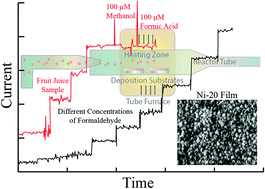Facile and scalable fabrication of nanostructured nickel thin film electrodes for electrochemical detection of formaldehyde
Abstract
Fluorine doped tin oxide (FTO) substrates were deposited with thin metallic nickel films, having distinguishable surface morphologies, via a rapid, facile, and scalable approach i.e., aerosol assisted chemical vapor deposition (AACVD). The growth patterns of the nickel deposits were studied, showing a coalescing behavior as a function of the deposition time in a hierarchical fashion. These studies were followed by electrochemical measurements to design an efficient sensor for formaldehyde detection. The electrochemical responses were correlated with the surface characteristics of the films, whereas the optimized parameters were subjected to the evaluation of sensing performances. The developed sensor demonstrated a detection limit of 8.3 × 10−6 M and a sensitivity of 0.18 A M−1 within a linear range of 0–6.5 mM. Further, the sensor showed a response time of less than 5 s, selectivity against similar concentrations of methanol and formaldehyde, and recovery of ∼102% in a spiked fruit juice sample. Finally, the commercial viability of the fabrication procedure is tested using batch production analysis, and the high reproducibility of the data shows a promising future in mass production. It is envisaged that such low-cost fabrication procedures can be converted into many useful applications in the future.



 Please wait while we load your content...
Please wait while we load your content...